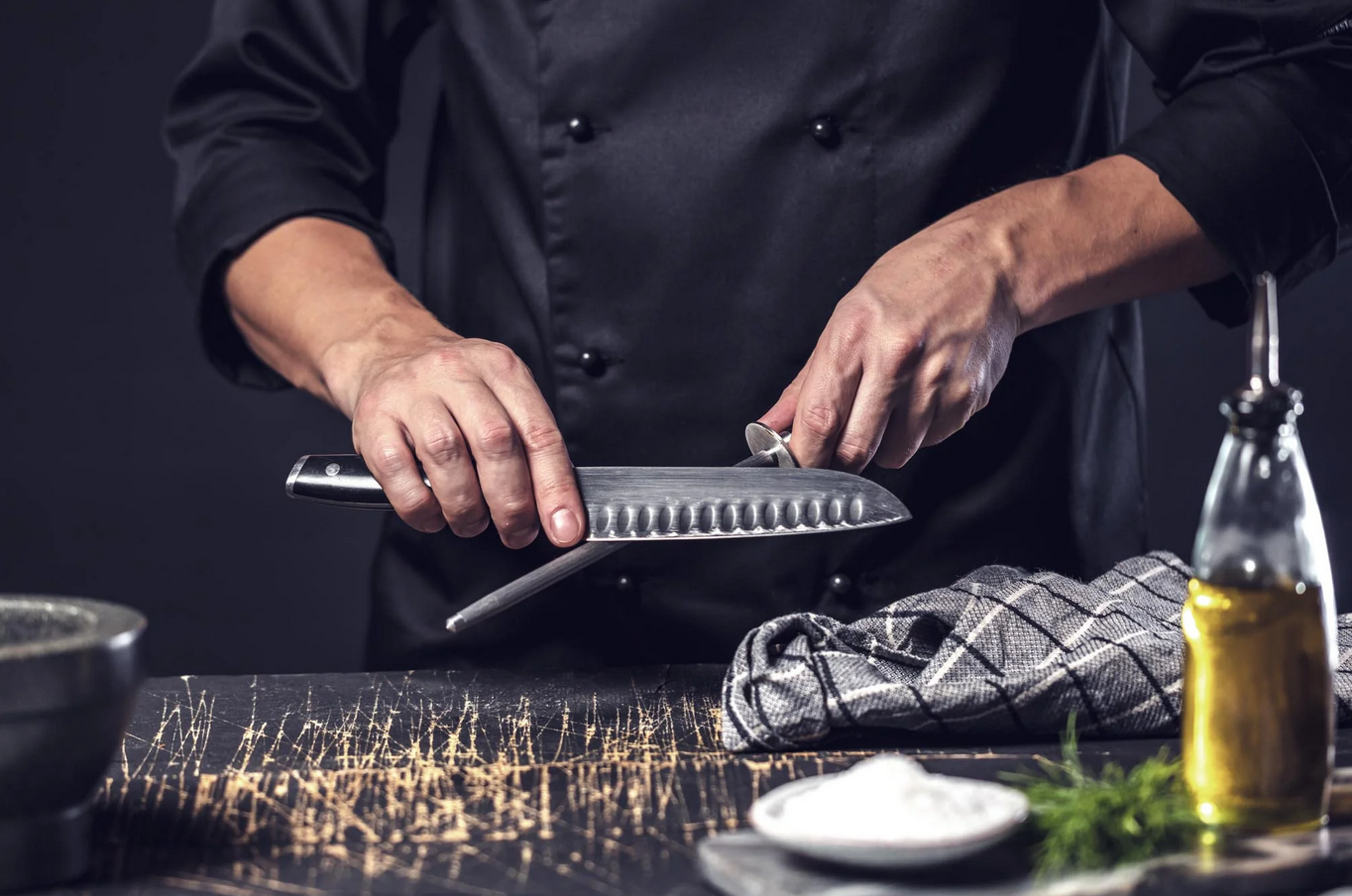Whether you are a professional chef, butcher, prepare in a restaurant, high up the processing chain or a budding home cook, it’s important to keep your knives sharp and usable; that is why you should use a steel knife sharpener.
This appliance is also called honing steel. In this step by step procedure, you will be able to understand how to sharpen your knife.
So, in this article, we are going to start with a short step-by-step guide to help you understand the importance of a steel knife sharpener, then, we’ll move onto sharpening at the very top of the industry: Giesser Knives. We’ll touch upon their history, but then we’ll discuss how you sharpen Giesser knives.
Step-by-Step Guide
Position the Steel
- Hold the steel vertically with the tip resting on a non-slip surface. Hold the handle with your non-dominant hand so that it stays steady and secure.
Angle the Knife
- Hold the heel of the knife edge on top of the steel at an angle of 15-20 degrees. The angle is everything.
Hone the Knife
- Draw the knife down and across the steel at the same angle. Begin at the heel of the blade and end at the tip. Repeat on each side of the blade 5 to 10 times.
Alternate Sides
- After honing one side, switch to the other side of the blade – hold the angle and pressure, and alternate sides with each stroke to keep the blade balanced.
Check the Sharpness
- When you’re done honing, test the sharpness of the knife against a sheet of paper or a tomato. If it slices easily, you’re set. If not, keep honing.
Clean the Knife
- Wipe the blade with a soft cloth before using it to remove any metal particles. This keeps your knife clean and ready for use.
Tips for Effective Sharpening
- The Consistent Angle: Maintaining the angle is important. Make sure you’re comfortable with the angle and can maintain it consistently through practice.
- Light Pressure: Use light, even pressure, to avoid damaging the blade.
- Regular Maintenance: Hone your knives regularly to keep them sharp and extend their lifespan.
In taking these steps, you can keep your knives sharp and ready at all times.
Then today, you will see into Giesser, who is one of the most famous knife makers in the world You also need to know how to use a steel knife sharpener with these:
The Legacy of Giesser Knives: Precision Steel Knife Sharpeners are a Must
Every Giesser Knife is a product of a long history. The company’s origin dates back to 1776 when it was founded in a small forge in Germany. Since then, Giesser has grown into one of the leading manufacturers of professional knives in the world.
To this day, more than 8,000 high-quality Giesser knives leave the factory every day. Giesser is still family-owned and has passed on its tradition of precision, durability and innovation to the sixth generation of knife-makers.
The Excellence of Giesser Blades
Giesser’s knives are well-made, and that is an understatement. The blades are made from good quality chrome molybdenum steel that is rust-resistant and durable.
The blade is ground to perfection through multiple rounds of sanding and polishing, which ensure that the knife is balanced and has perfect sharpness. Professional chefs and butchers across the globe use Giesser’s knives because they are considered the best.
Perfecting the Sharpening of Giesser Knives
How to Sharpen Your Knife
Sharpening Giesser knives on a regular basis is important to keeping them in prime condition and maintaining their superior performance. Here’s how to do it.
- Get the Right Tools: Use a steel knife sharpener or a sharpening stone at least weekly.
Maintain the Angle
- Hone: Hone the knife at the same angle (15 to 20 degrees usually works well) while maintaining consistent contact with the sharpening tool surface. A sharp edge is formed by maintaining a consistent angle.
- Sharpen Often: Sharpening with honing steel will help maintain the edge between an intensive sharpening session.
- Careful With That Razor: In using the sharpening stone, keep it well lubricated with water to avoid overheating of the steel.
Check the Edge
- When you’ve finished honing, check the sharpness of the knife by cutting a sheet of paper or a tomato. If the knife cuts with ease, it’s ready to use.
OVERVIEW of Giesser Knives
Following these steps will help you to get the best out of your Giesser knives, treating them as they deserve to be treated so that you can enjoy them for as long as possible – reliable, razor-sharp and free of chips and cracks. It will mean every slice is an effortless part of your culinary masterpiece.
SUMMARY
Even if you are operating at the lower price point or the premium price point of Giesser knives, for example, you still need to understand why and where steel knife sharpeners are the right choice. You need to know what steels work best with which blades and take it easy on the blade. Learning how to sharpen your knife is a cool learning experience. Make the handle nice and smooth from tip to toe, and you’ll be fine.

